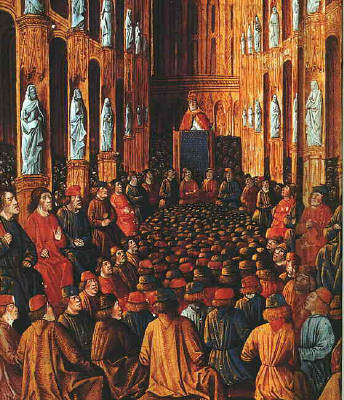The First Crusade
The First Crusade, which took place between 1096 and 1099, was the first of many ‘armed pilgrimages’ to the Holy Land and was the only one to be successful.
The crusade marked the church’s successful attempt to reclaim Jerusalem from the Muslims following summons from Pope Urban II to do so. The Pope ordered the crusade in response to Alexius I of Constantinople’s plea for help, after he contacted the most powerful leader in the Christian faith following the capture of Jerusalem by the Muslims in 1076.
Alexius told the Pope he required help defeating the Seljuq Turks, and wanted to restore the ability of Christian pilgrims to visit the Holy Land without risking serious danger on their journey.
Pope Urban called for a crusade at the Council of Clermont in November 1095, promising the Indulgence to any Christian who took up the cross for “devotion alone. This would mean that person’s sins would be forgiven if they went on the crusade, and prompted many to take up the challenge.

The journey was even more dangerous than many of the pilgrims had banked on, forcing armies to mark through Europe in intense conditions. Pilgrims faced hot weather, famine, disease and attacks from the ‘infidel’ along their journey.
However, the pilgrims themselves also committed atrocities along their two-year journey, including the programs against the Jews in northern Germany.
The first target of the crusaders was the city of Nicaea, which fell quickly due to its leader being absent. After handing custody of the city to the Byzantines, the crusaders next challenged Antioch - a Turkish city with strong defences. Unlike the first, this siege took months and left many of the crusaders weak and injured. According to Guibert de Nogent, a crusade chronicler, hunger began to “gnaw at their weak hearts, and their dried-up stomachs cracked open”. In total it took seven months of Antioch to fall, costing the crusaders greatly. However, this victory opened up the road to Jerusalem, and it was in the summer of 1099 when they finally reached their destination.
When they arrived in the Holy Land, the crusaders were weak and suffering from starvation, so a fast victory was necessary. However, their belief that penitential acts would please God encouraged them to march on, bare foot, around the city walls.
Within just one week the Genoese were able to break to walls of the city and siege Jerusalem, massacring Jews and Muslims as they went. In fact, one chronicler described the streets as flowing “a river of blood one foot deep”.
Once the city was taken, the Christians put in place a king for the newly created Kingdom of Jerusalem, and they also established the “crusader states” of Edessa, Antioch, Jerusalem, Tripoli and Syria.
Sadly for the Christians, the church couldn’t hold onto the territory for long, and it was only in 1145 that the Pope was needed to call the Second Crusade to reclaim Edessa.
What were the motivations of the crusaders?
The Church was at the heart of the running of Medieval Europe, and the core of the daily lives of those living in the Middle Ages. As such, the First Crusade was heavily influenced by religion, in spite of the financial gain that the church would benefit from upon reclaiming Jerusalem.
In fact, in his speech in Clermont, Pope Urban urged people to take up the cross based on purely devotional reasons, suggesting that they “take the road to the Holy Sepulchre, rescue that land from a dreadful race and rule over it yourselves, Jerusalem prays to be liberated”. Religious reasons were also given for the violence that would take place on the crusade, with the Pope stating that “Christ commands it”.
In spite of this, some historians have argued that the crusaders were purely motivated by money - many of them were incredibly poor and some were even criminals, which would make the prospect of earnings and territory in the Holy Land incredibly appealing. However, Indulgence still remained the biggest prize, with Christians offered “imperishable glory of the kingdom of heaven” if they were to take part.
Many modern historians have concluded that the figures, which show that 659 people left on the crusaders and only 104 settled, support the idea that the crusade was a pilgrimage with a spiritual focus.
See also: The Second Crusade
MLA Citation/Reference
"The First Crusade". HistoryLearning.com. 2025. Web.
